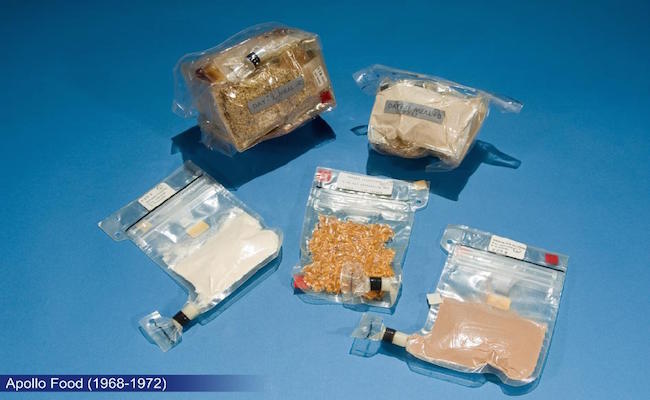How Astronauts Eat Food in Space

Have you ever wondered how astronauts eat in space? How do they pour milk? How do they eat their peas? Read on to find out about eating in space.
In the early years of traveling to space, astronauts ate their food from an aluminum tube. If you imagine a toothpaste tube you have the right idea. These tubes did not take up too much space and could store for long periods of time. John Glenn was the first astronaut in space to eat, and he enjoyed a tube of applesauce. The variety of foods remain limited and thankfully other food storage systems were later developed. One of the newer methods involved freeze drying foods.
How to Freeze Dry Food
- Fresh or cooked foods are placed in a dryer and frozen to -40 degrees Fahrenheit or colder
- Once frozen, the freeze dryer creates a powerful vacuum around the food.
- Then, as the food begins to warm, the ice transitions into vapor and evaporates.
- The freeze-dried food is then sealed in moisture and oxygen-proof packaging (Mylar bags, mason jars, or cans) along with an oxygen absorber to ensure freshness until opened.
- When water is added to the food it regains its original fresh flavor, aroma, and appearance!

Apollo Space Food
Astronauts added water to the freeze dried food with a small water gun that contained cold water. As technology advanced warm water later provided a warm meal. Powdered drink pouches came equipped with straws preventing liquids from making a mess. Today, all types of condiment packets can travel into space without having special pouches attached.
How to Keep the Food from Floating
To keep the food from floating around, special trays equipped with velcro, allowed food cups to remain within the tray. Astronauts then could eat sitting down, and enjoy their meal. Powdered drink pouches come equipped with straws preventing liquids from making a mess. All types of packets containing condiments can travel into space without having special pouches attached. The meal tray becomes the astronaut’s dinner plate and enables him or her to choose from several foods at once, just like a meal at home. Without the tray, the contents of one container must be completely consumed before opening another. The tray also holds the food packages in place and keeps them from floating away in the microgravity of space.
Astronauts use knives, forks, and spoons. A pair of scissors cuts open the packages. Following the meal, food containers are discarded in the trash compartment below the mid-deck floor. Pre-moistened towelettes clean the utensils after the meal.
What Do Astronauts Eat On the International Space Station ?
Astronauts aboard the International Space Station eat three classifications of food.
Natural Form (NF) refers to food that does not need to be processed
Examples: Crackers, tortillas, nuts, granola bars, condiments, candy, and cookies.
Rehydratable (R) foods have had the water removed from them. Once the crew is ready to eat, hot water is injected into the pouch to restore the food to its normal form.
Examples: Cottage cheese, shrimp cocktail, scrambled eggs, noodles, mashed potatoes, quiche, borsch, milk, rice, macaroni & cheese, sausage patties, teriyaki vegetables, spaghetti with meat sauce, and grits.
Thermostabilized (T) foods are heated to a level sufficient to kill harmful microorganisms and enzymes and then packaged in cans, cups, or pouches.
Examples: Chopped pork with eggs, beef with vegetables, split pea soup, pike perch in Baltika sauce, tofu with Hoisin sauce, minestrone soup, grilled pork chop, tomato basil soup, chicken in white sauce, African sweet potato and peanut soup, and lasagna.
Without a refrigerator, anything fresh, such as apples and oranges, must be eaten within a few days. Warming ovens heat canned foods, and a suitcase sized oven warms packet foods.
Scientists constantly monitor and evaluate the nutritional needs of astronauts at the ISS. Making sure they have the foods they enjoy along with keeping up their daily calorie requirements is essential. Exciting days are ahead as the astronauts learn to grow some of their food in space. It has come a long way since aluminum tubes.
